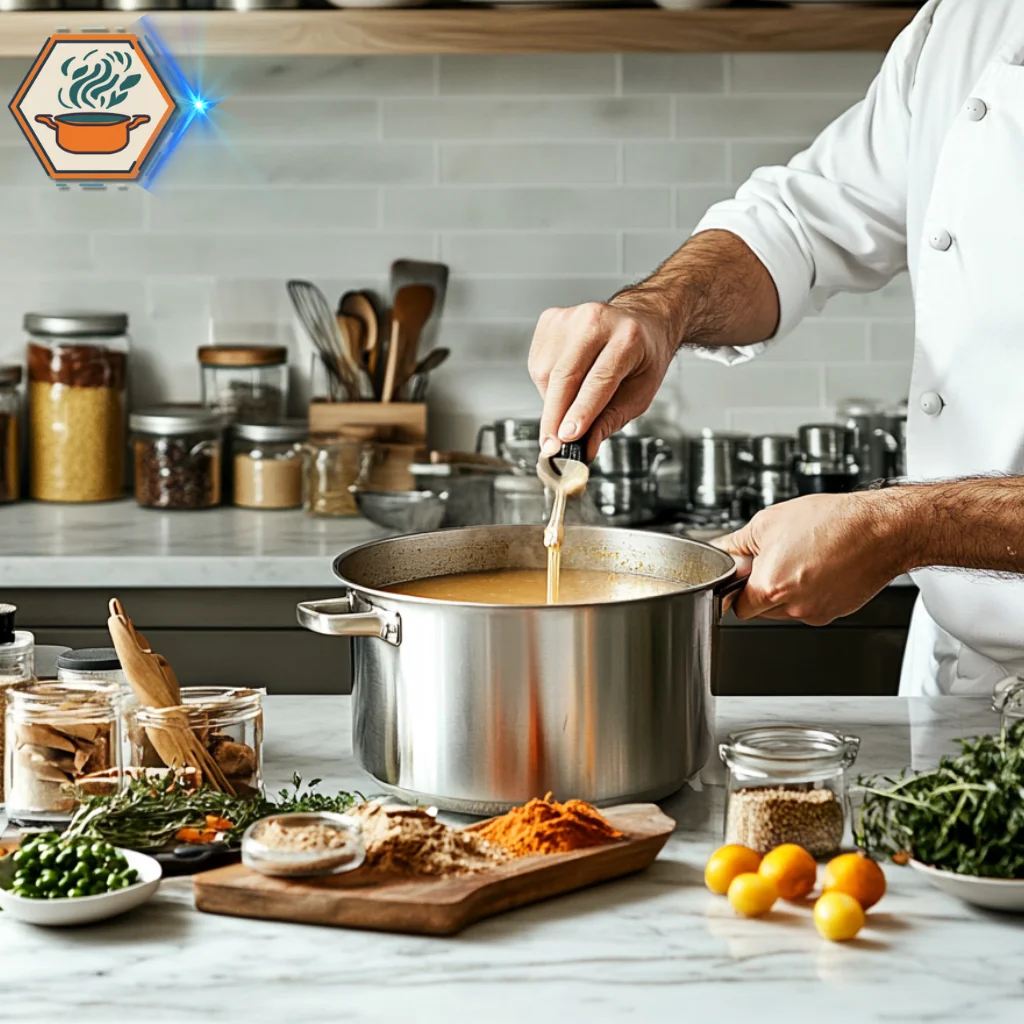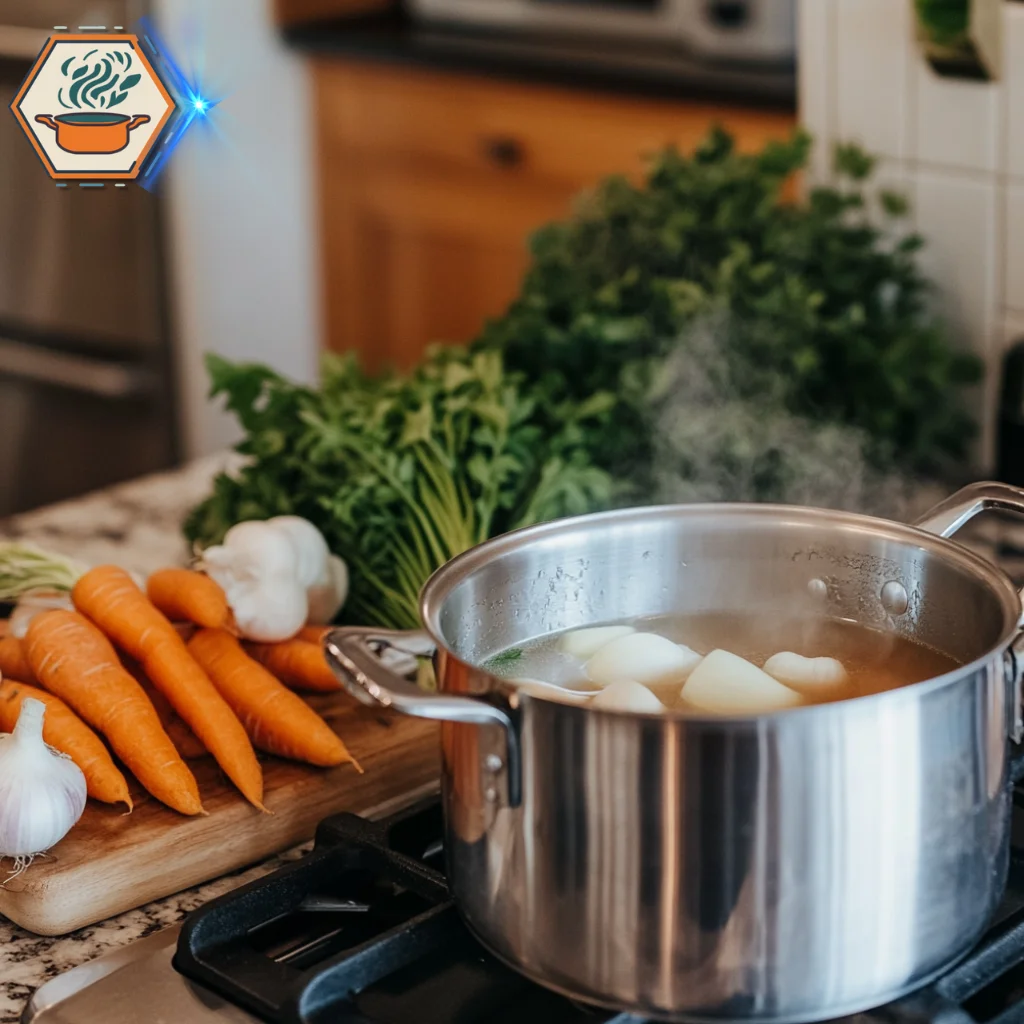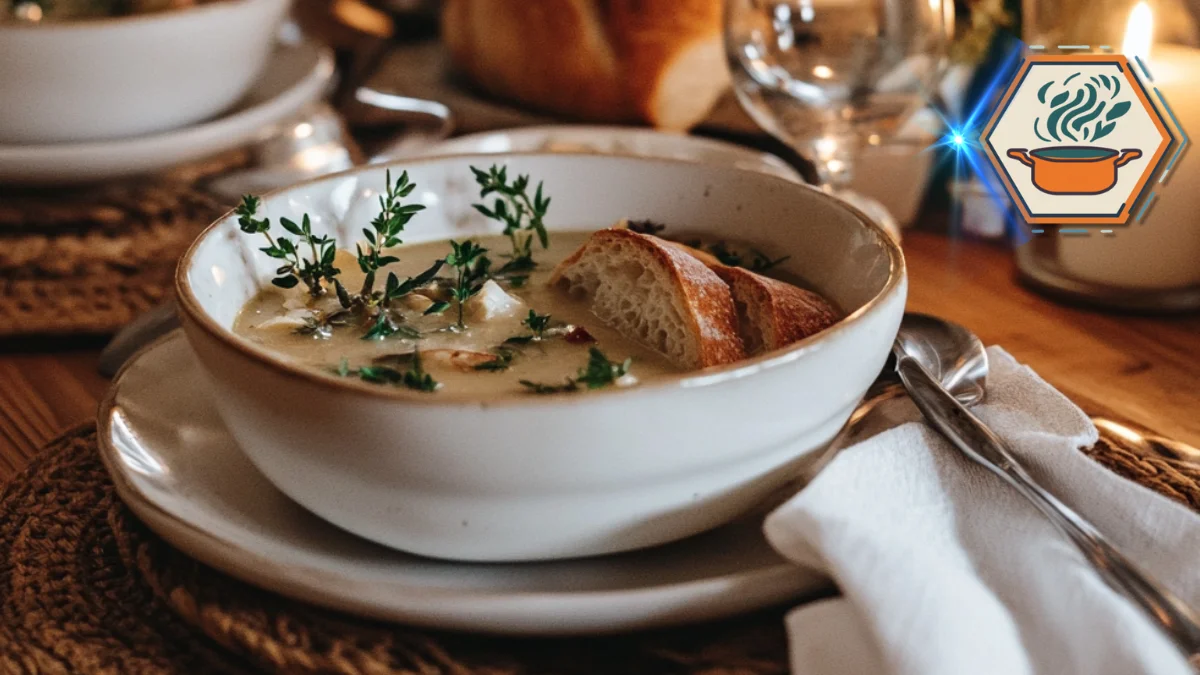Table of Contents
Understanding Bone Broth Basics
Bone broth has been cherished for centuries across cultures for its nutritional benefits and culinary versatility. But what exactly is it? How does it differ from stock or regular broth? Let’s delve into the fascinating world of bone broth, its history, and its essential components to help you understand why it has become a staple in modern kitchens.
What is Bone Broth?

Bone broth is a nutrient-rich liquid made by simmering animal bones and connective tissues with water, vegetables, and herbs for an extended period. This slow cooking process extracts collagen, minerals, and gelatin, creating a flavorful and health-boosting elixir. Unlike stock or regular broth, bone broth is simmered for much longer—sometimes up to 48 hours—to maximize the extraction of nutrients.
The History and Origins of Broth of Bones
The origins of bone broth date back thousands of years, with evidence of its use in traditional Chinese medicine for healing and nourishment. Ancient cultures around the world used bone broth to make the most of every part of an animal, ensuring nothing went to waste.
Differences Between Broth of Bones, Stock, and Regular Broth
- Stock: Typically simmered for a shorter time (4-6 hours) and focuses on extracting flavors from bones and aromatics. Stock has a richer taste but fewer nutrients compared to bone broth.
- Regular Broth: Made from meat (not bones) and cooked for a short duration, usually less than two hours. It’s lighter in flavor and primarily used in soups.
- Bone Broth: Simmered for 12-48 hours, prioritizing nutrient extraction over flavor. It’s thicker and gelatinous when cooled due to its high collagen content.
Nutritional Benefits of Bone Broth
Bone broth is not just a comfort food; it’s a powerhouse of nutrients that can support your overall health. Let’s explore the key nutrients and benefits derived from this age-old remedy.
- Collagen and Gelatin: These proteins are essential for joint health, skin elasticity, and gut health. When bones are simmered, collagen breaks down into gelatin, which supports digestion and strengthens the gut lining.
- Amino Acids: Bone broth contains glycine, proline, and glutamine, which promote muscle repair, boost immunity, and enhance cognitive function.
- Minerals: Calcium, magnesium, and phosphorus are leached from the bones, providing essential nutrients for bone and tooth health.
Health Advantages
- Improved Gut Health: Bone broth’s gelatin soothes the digestive tract and helps with leaky gut syndrome.
- Joint Support: The glucosamine and chondroitin in bone broth reduce inflammation and improve joint mobility.
- Immune System Boost: Rich in nutrients, bone broth supports a strong immune system.
Types of Bones to Use for Broth of Bones
The choice of bones plays a critical role in the flavor and nutrient content of your bone broth. Here are some popular options:
- Beef Bones: Known for their robust flavor and high collagen content, beef bones are ideal for long-simmering broths.
- Chicken Bones: Affordable and versatile, chicken bones make a lighter broth that’s rich in collagen.
- Pork Bones: These bones add a slightly sweet flavor and are excellent for enhancing the richness of your broth.
- Fish Bones: Fish bones create a quick-cooking broth that’s rich in omega-3 fatty acids and essential minerals.
Organic vs. Conventional Bones
When making bone broth, it’s best to use organic, grass-fed, or pasture-raised bones. These options ensure higher-quality nutrients and fewer toxins. Conventional bones may contain traces of antibiotics or hormones, which could leach into your broth during the cooking process.
- Look for marrow bones, knuckle bones, and oxtails for beef.
- For chicken, opt for backs, feet, and wings, as they’re rich in collagen.
Essential Equipment for Cooking Broth of Bones
To achieve the perfect Broth of Bones, having the right tools is essential. Here’s a breakdown of the equipment you’ll need:
- Stockpot: A large, heavy-duty stockpot is perfect for stovetop simmering. Look for one with a capacity of at least 12 quarts.
- Slow Cooker: A slow cooker allows for a hands-off approach, making it convenient for simmering broth overnight.
- Instant Pot: This pressure cooker dramatically reduces cooking time, allowing you to prepare bone broth in under 4 hours while still extracting nutrients.
- Strainer or Cheesecloth: Use these tools to remove any solids from your finished broth, ensuring a clear liquid.
- Utensils: A ladle for skimming foam and a slotted spoon for removing bones will make the process smoother.
For detailed instructions on bone broth recipes, visit Wikipedia’s page on bone broth.
The Cooking Process: Timing, Techniques, and Tips for Bone Broth

Making Broth of Bones is both an art and a science. The timing, techniques, and ingredients you use can make the difference between a rich, nutrient-dense broth and a lackluster liquid. In this guide, we’ll explore the ideal cooking times, step-by-step instructions, and practical tips for crafting the perfect bone broth. By following these guidelines, you can maximize the flavor and nutritional benefits of your broth.
How Long Should You Cook Broth of Bones?
The cooking time for bone broth depends on the type of bones you use and the method of cooking. Proper timing ensures that you extract the maximum nutrients while avoiding overcooking, which can cause an unpleasant taste or cloudy texture.
- Beef Bones: 24 to 48 hours for optimal collagen and mineral extraction.
- Chicken Bones: 12 to 24 hours, as these bones break down faster than beef.
- Fish Bones: 4 to 6 hours, as their delicate structure releases nutrients more quickly.
- Pork Bones: 16 to 24 hours, yielding a slightly sweet and rich broth.
Pro Tip: Using a slow cooker or pressure cooker can help maintain consistent heat for extended cooking times, ensuring a better-quality broth.
Why Timing Matters
Cooking bones for too short a time can leave nutrients locked inside, while overcooking may cause the release of undesirable flavors. Monitor your broth carefully and taste it periodically to ensure the best results.
Step-by-Step Guide to Cooking Bone Broth
Follow this detailed process to create a bone broth that’s bursting with flavor and nutrition:
- Prepare the Bones
- Clean the Bones: Rinse under cold water to remove impurities.
- Roast the Bones: For beef or pork, roast at 400°F (200°C) for 30-45 minutes to enhance the flavor.
- Add Aromatics and Vegetables
- Common choices include onions, carrots, celery, and garlic. These enhance the broth’s flavor profile.
- Herbs like bay leaves, thyme, and parsley add depth to the broth.
- Simmer Gently
- Add the bones and aromatics to a pot with cold water.
- Bring to a gentle boil, then reduce to a simmer. Skim off foam and impurities that rise to the surface.
- Monitor Cooking Time
- Use a timer to ensure the broth simmers for the recommended duration based on the type of bones.
- Avoid stirring frequently, as this can cause the broth to become cloudy.
- Strain the Broth
- Use a fine-mesh strainer or cheesecloth to remove solids, leaving you with a clear, nutrient-packed liquid.
- Cool and Store
- Let the broth cool before transferring to jars or containers. Refrigerate for up to 5 days or freeze for longer storage.
Internal Link Opportunity: Learn how to incorporate your freshly made bone broth into recipes like this How do you make a puree? for a flavorful and healthy twist.
Tips for Perfect Broth of Bones Every Time

Mastering bone broth takes practice, but these tips can help you avoid common pitfalls and elevate your results:
- Use Acid for Mineral Extraction
Adding a splash of apple cider vinegar or lemon juice at the beginning of the cooking process helps release minerals from the bones. - Avoid Overloading the Pot
Too many bones or vegetables can result in a murky broth. Maintain a proper balance to ensure clarity and flavor. - Skim Frequently
Skimming off foam and fat during the initial stages of cooking prevents impurities from settling into the broth. - Don’t Overseason
Add salt sparingly during cooking. It’s better to season your broth when using it in recipes.
For more insights into the nutritional benefits of Broth of Bones, visit Healthline’s guide.
How to Adjust Cooking Times Based on Cooking Methods
Each cooking method has its unique advantages. Here’s how to adjust your approach depending on your equipment:
- Stovetop:
- Traditional and reliable but requires constant monitoring.
- Ideal for those who want to control the simmering process manually.
- Instant Pot:
- Reduces cooking time significantly (2-4 hours for most bones).
- Preserves nutrients while achieving a rich, flavorful broth.
- Slow Cooker:
- Perfect for hands-off cooking over long periods.
- Allows you to simmer overnight or during the day with minimal effort.
Storage, Uses, and Enhancing Your Bone Broth

After mastering the art of making bone broth, the next crucial step is proper storage and creative utilization. Bone broth’s versatility extends beyond soups; it can be a foundation for numerous recipes, a nutritious daily drink, or even a secret ingredient for flavor-packed dishes. In this article, we’ll explore the best practices for storing bone broth, innovative ways to use it, and tips for enhancing its flavor to suit your needs.
Storing Broth of Bones : Best Practices
Proper storage is essential to maintain the quality and freshness of your bone broth. Here are the best practices:
- Cooling the Broth
- After straining the broth, let it cool at room temperature for about an hour.
- Avoid leaving it out for too long, as this can lead to bacterial growth. Use an ice bath to speed up cooling if needed.
- Refrigeration
- Store Broth of Bones in airtight glass jars or BPA-free plastic containers.
- Broth can last in the refrigerator for up to 5 days. For better freshness, skim the fat layer off the top before storage, but keep it if you want additional flavor when reheating.
- Freezing for Long-Term Storage
- Freeze broth in silicone molds, ice cube trays, or freezer-safe containers for easy portioning.
- Frozen Broth of Bones can last for up to 6 months without losing quality. Label each container with the date for easy tracking.
- Reheating Safely
- Reheat only the portion you plan to use.
- Bring the broth to a gentle boil to ensure it’s safe for consumption. Avoid reheating repeatedly, as it can degrade the flavor and nutrients.
Pro Tip: Silicone ice cube trays are perfect for freezing small portions of broth. This makes it easier to use in recipes or for a quick drink.
Creative Ways to Use Bone Broth
Bone broth isn’t just for sipping or soups. Here are innovative ways to incorporate it into your meals:
- As a Base for Soups and Stews
- Enhance classic soups like chicken noodle or minestrone with nutrient-rich bone broth.
- Cooking Grains and Legumes
- Substitute water with bone broth when cooking rice, quinoa, or lentils to add depth and nutrition.
- In Smoothies
- Yes, Broth of Bones in smoothies! Use small amounts for a savory twist in vegetable-based smoothies.
- For Sauces and Gravies
- Use bone broth as a base for sauces or gravies to enhance their flavor and nutrient profile.
- Making Bone Broth Ice Cubes
- Freeze into cubes and add to sautéed vegetables, pasta dishes, or stir-fries for a quick flavor boost.
- Daily Wellness Drink
- Warm a mug of bone broth and sip it plain or season it with turmeric, ginger, or lemon for an immunity boost.
Enhancing Your Bone Broth: Advanced Tips
While bone broth is already delicious and nutrient-packed, there are ways to take it to the next level:
- Using Vinegar for Maximum Mineral Extraction
- Add 1-2 tablespoons of apple cider vinegar before simmering to extract more calcium and magnesium from the bones.
- Adding Herbs and Spices
- Customize the flavor with additions like turmeric, ginger, rosemary, or thyme. These herbs not only boost taste but also add extra health benefits.
- Incorporating Vegetables for Depth
- Enhance the sweetness and complexity by adding fennel, leeks, or parsnips during cooking.
- Roasting Bones Before Simmering
- For a deeper, richer flavor, roast the bones in the oven at 400°F (200°C) before starting the broth.
- Experiment with Different Bones
- Use a mix of bones (chicken, beef, pork) to create unique flavor profiles. Fish bones add a light, delicate flavor that pairs well with Asian dishes.
- Gelatinous Broth: The Sign of Success
- A gelatinous broth when cooled indicates that you’ve successfully extracted collagen. If it’s not gelled, simmer longer or add more collagen-rich bones like chicken feet.
FAQs About Broth of Bones
- Can I use bone broth every day?
Yes, bone broth can be consumed daily as a nutrient-dense drink or as part of meals. It’s especially beneficial for gut health, skin, and joint support. - How can I tell if my bone broth has gone bad?
Look for signs like an off smell, unusual color, or mold. If you’re unsure, it’s best to discard it. - What are the best vegetables to add to bone broth?
Onions, carrots, celery, garlic, and leeks are classic options. Feel free to experiment with others like mushrooms or tomatoes for unique flavors. - Does longer cooking always mean better broth?
Not necessarily. Overcooking can cause off flavors. Stick to recommended cooking times based on the type of bones you’re using. - Can I reuse the bones for a second batch?
Yes, but the second batch will be less flavorful and nutrient-rich. You can combine it with fresh bones for better results.
Conclusion
Bone broth’s versatility and health benefits make it a must-have in any kitchen. By following proper storage practices, experimenting with creative uses, and enhancing its flavor, you can elevate your cooking and wellness routine. Whether you sip it daily or use it to transform dishes, bone broth offers endless possibilities.


1 thought on “How many hours should you cook bone broth?”